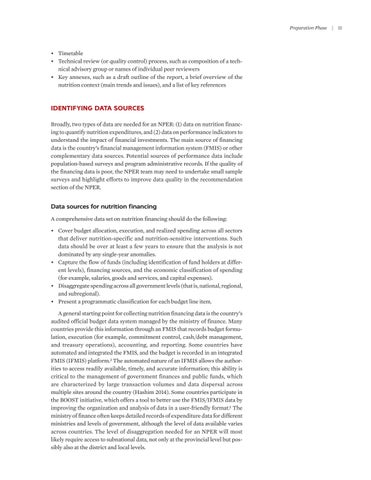Preparation Phase
• Timetable • Technical review (or quality control) process, such as composition of a technical advisory group or names of individual peer reviewers • Key annexes, such as a draft outline of the report, a brief overview of the nutrition context (main trends and issues), and a list of key references
IDENTIFYING DATA SOURCES Broadly, two types of data are needed for an NPER: (1) data on nutrition financing to quantify nutrition expenditures, and (2) data on performance indicators to understand the impact of financial investments. The main source of financing data is the country’s financial management information system (FMIS) or other complementary data sources. Potential sources of performance data include population-based surveys and program administrative records. If the quality of the financing data is poor, the NPER team may need to undertake small sample surveys and highlight efforts to improve data quality in the recommendation section of the NPER.
Data sources for nutrition financing A comprehensive data set on nutrition financing should do the following: • Cover budget allocation, execution, and realized spending across all sectors that deliver nutrition-specific and nutrition-sensitive interventions. Such data should be over at least a few years to ensure that the analysis is not dominated by any single-year anomalies. • Capture the flow of funds (including identification of fund holders at different levels), financing sources, and the economic classification of spending (for example, salaries, goods and services, and capital expenses). • Disaggregate spending across all government levels (that is, national, regional, and subregional). • Present a programmatic classification for each budget line item. A general starting point for collecting nutrition financing data is the country’s audited official budget data system managed by the ministry of finance. Many countries provide this information through an FMIS that records budget formulation, execution (for example, commitment control, cash/debt management, and treasury operations), accounting, and reporting. Some countries have automated and integrated the FMIS, and the budget is recorded in an integrated FMIS (IFMIS) platform.3 The automated nature of an IFMIS allows the authorities to access readily available, timely, and accurate information; this ability is critical to the management of government finances and public funds, which are characterized by large transaction volumes and data dispersal across multiple sites around the country (Hashim 2014). Some countries participate in the BOOST initiative, which offers a tool to better use the FMIS/IFMIS data by improving the organization and analysis of data in a user-friendly format.4 The ministry of finance often keeps detailed records of expenditure data for different ministries and levels of government, although the level of data available varies across countries. The level of disaggregation needed for an NPER will most likely require access to subnational data, not only at the provincial level but possibly also at the district and local levels.
|
11

